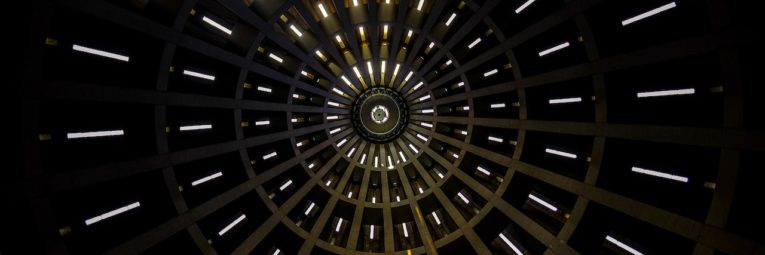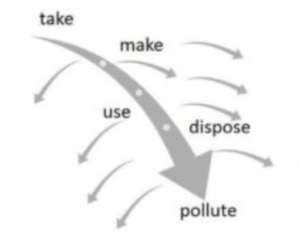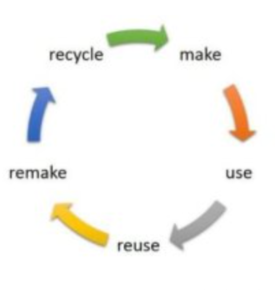
No, we’re not advocating that businesses like ours waste time going nowhere. We’re talking about the increasing importance of the new Circular Economy to every industry today, including lighting.
The Circular Economy began life as an environmentally-friendly philosophy back in the 1960s and it’s now picking up momentum as a practical way for businesses to adopt more sustainable habits themselves and to encourage them in others. It’s all about using our natural resources in a more intelligent way. The aim is for 100% renewable energy and zero waste to landfill, while we still have a long way to go, the building blocks are already being put in place.
It might help you better understand what the Circular Economy is by giving you a brief explanation of the traditional alternative. So, in a linear economy, products are designed in a way that inevitably leads to them ending up as waste. This model is often known as ‘take, make, waste’. Whilst steps have been taken to reduce the inclusion of single use materials, increasing the percentages of both recycled and recyclable materials, products still invariably have and end of life.

Increasing interest in sustainability initiatives like the Circular Economy is no great surprise bearing in mind the problems the world now finds itself in. A study from the World Economic Forum reported that 32% of the 78 million tons of packaging produced annually is left to flow into our oceans; the equivalent of pouring one garbage truck of plastic into the ocean every minute.
This has to stop.
We need to manufacture products with minimal waste that can be upgraded, serviced, reused, refurbished, or recycled.

In the circular economy, counterintuitively, recycling is not always the best solution. It will often be better for us to design products with components that can easily be replaced to prolong the life of luminaires that otherwise would have been thrown away. Although, at the end of the day, recycling and not landfill is the answer.
While significant environmental benefits are sure to derive from the more sustainable use of resources, the Circular Economy might not seem so palatable from a business point of view.
This whole way of doing things requires a mindset adjustment around growth and profitability but, with a little agility, businesses can benefit too.
Yes, if products are being designed to be reused, refurbished, upgraded and last as long as possible then it follows we’re going to be selling fewer products. However, more effective use of products, components and materials is expected to lead to cost savings and the opportunity to develop new markets.
Smart lighting is an example of how this can work in action. Companies can benefit from installing super-efficient and long-lasting LEDs, with lighting companies able to profit from the managed services and maintenance that will extend the life of the products.
Meanwhile, smart lighting controls can monitor modern lighting solutions, indicating when maintenance is required, cutting down on waste as well as downtime.
Still, in the relatively early stages of development, it’s inevitable that not everyone will grasp how to make the Circular Economy work for their own business. Companies like ours can benefit from guidelines that identify best practice behaviour.
The Lighting Industry Association (LIA) have taken the helpful step of issuing an interim guide. The purpose of the guide is to set out a common understanding of this particular sustainability model and predict its challenges and opportunities. It focuses on the need to design out waste and pollution from manufacturing processes while encouraging the regeneration of natural systems.
Phi Lighting is committed to exceeding the requirements of legislation, codes of practice and regulations relevant to our industry. Accepting the manufacture of goods has an impact on the environment, our aim is to minimise our total environmental impact through the use of efficient technologies, to minimise lifecycle costs and power consumption of our products. That’s why we love the intelligent approach of the Circular Economy.
As we all search for more sustainable ways of doing things, there’s no questioning that we need to move away from the old linear economy. It’s time to embrace the new Circular Economy that will benefit us all, and the planet we live on, for generations to come.
I can rely on Phi being proactive on issues arising.
Relationships & Empathy
Phi understands us, our scope and our limitations.
Relationships & Empathy
Phi delivers a good solution, which is more than just a product. Their service is good, they talk through schemes with us and there is more to it than just a catalogue.
Technical Skills
The main asset of Phi is people and the high level of technical backup they provide. For example with their competitors I meet a salesman and not a technical salesman. This difference is crucial.
Technical Skills
Good quality products at a reasonable price.
Price
Phi is not the cheapest supplier but they offer quality architectural fittings.
Price
Phi’s personal service is appreciated and differentiates them.
Service
During completed projects, we have been happy with the performance and communication from Phi. I can rely on Phi being proactive on issues arising.
Service
I see Phi for architectural led office foyers, reception areas, bespoke spaces in office blocks and good architectural lighting for commercial developments
Spaces
Appropriate for the commercial sector in particular and other places where there is a modern style requirement as befits their current product range.
Spaces
Phi is most suited to commercial offices, associated rooms and educational buildings.
Spaces
Phi delivers a good solution, which is more than just a product.
Perception & Image
We are project focused; there are lots of people in the industry but it is questionable whether they want to help and support properly. Why change to someone who may let you down, you stick with the best.
Perception & Image
Phi is not mainstream but a specialist niche architectural supplier who is a little bit different.
Perception & Image
Phi offer support, which sets them apart.
Perception & Image
Phi is a strong quality architectural supplier, giving good advice where we are lacking.
Perception & Image
Phi offer a great level of experience, supply, service and back up.
Perception & Image
I can rely on Phi being proactive on issues arising.
Relationships & Empathy
Phi understands us, our scope and our limitations.
Relationships & Empathy
Phi delivers a good solution, which is more than just a product. Their service is good, they talk through schemes with us and there is more to it than just a catalogue.
Technical Skills
The main asset of Phi is people and the high level of technical backup they provide. For example with their competitors I meet a salesman and not a technical salesman. This difference is crucial.
Technical Skills
Good quality products at a reasonable price.
Price
Phi is not the cheapest supplier but they offer quality architectural fittings.
Price
Phi’s personal service is appreciated and differentiates them.
Service
During completed projects, we have been happy with the performance and communication from Phi. I can rely on Phi being proactive on issues arising.
Service
I see Phi for architectural led office foyers, reception areas, bespoke spaces in office blocks and good architectural lighting for commercial developments
Spaces
Appropriate for the commercial sector in particular and other places where there is a modern style requirement as befits their current product range.
Spaces
Phi is most suited to commercial offices, associated rooms and educational buildings.
Spaces
Phi delivers a good solution, which is more than just a product.
Perception & Image
We are project focused; there are lots of people in the industry but it is questionable whether they want to help and support properly. Why change to someone who may let you down, you stick with the best.
Perception & Image
Phi is not mainstream but a specialist niche architectural supplier who is a little bit different.
Perception & Image
Phi offer support, which sets them apart.
Perception & Image
Phi is a strong quality architectural supplier, giving good advice where we are lacking.
Perception & Image
Phi offer a great level of experience, supply, service and back up.
Perception & Image
Phi Lighting Ltd
Unit 9, Brook Business Park, Brookhampton Lane, Kineton, CV35 0JA
Phone: +44 (0)1926 640 366Fax: +44 (0)1926 641 747Email: quotes@phi-lighting.com
Phone: +44 (0)203 875 6484
